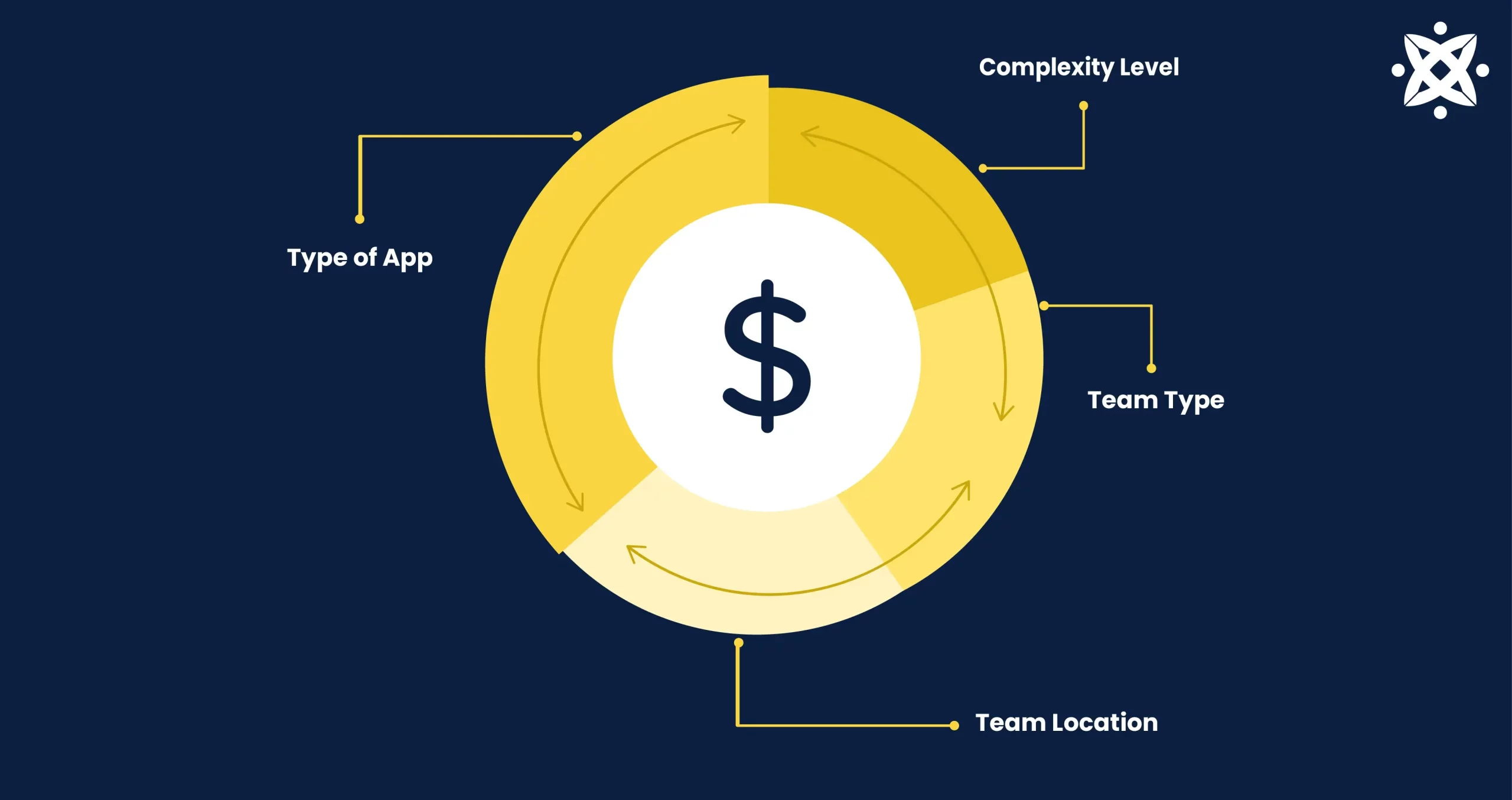Are you a startup founder, serial entrepreneur, or investor thinking of creating a mobile application?
If yes, a question that’ll definitely be paramount in your mind is “how much does mobile app development cost?”
The cost of developing a mobile application in Canada ranges from CAD15,000 to CAD300,000 for most applications.
However, your exact price is determined by the type, complexity, business model, and development team.
The MVP for a typical application of average complexity at $40/hour is:
- Android–$65,000
- iOS–$80,000 and
- Cross-platform–$100,000.
When it comes to creating an application, you’ll get what you pay for. Pay beneath a certain threshold, and you’re undoubtedly hiring a low-quality team.
On the other hand, hire cost-effectively, and you’ll have a perfect price-quality ratio.
This article will discuss the intricacies and nitty-gritty of pricing a mobile application.
Points we’ll discuss in this article entail:
- App development costs
- Factors that impact the cost of building an application
- App development costs that are easily overlooked
- App development cost by example.
Let’s delve right into the crux of the article!
Looking for the best mobile app development agency to bring your ideas to life?
Sign up for a FREE 30-minute consultation with experts at Intelivita now!
How Much Does it Cost to Develop a Mobile Application in Canada?
The average cost of developing a mobile app in Canada ranges between $15,000 and $300,000.
However, the exact amount you’ll pay may slightly differ with:
- The product complexity
- The host operating system
- The type of application
- The development team involved
- The location of the development team.

These factors can affect mobile application development by as much as 100%. Thus, it’s imperative to consider what they entail and how to influence those factors to reduce development costs.
Let’s help you understand their intricacies:
Mobile App Development Cost Defined by Product Complexity
The complexity of a mobile application refers to the number of features, functionalities, components, and interactions in the product’s codebase.
You may also describe complexity as the level of difficulty a coder faces in creating a mobile application.
For example, a typical fintech mobile application is more complex than a single-page to-do list app due to the number of functionalities and features the latter has.
However, that a mobile app has a single purpose doesn’t entirely imply that it’s not complex. Some of them are more complex than most multi-purpose apps. Some examples are:
- Instagram: Albeit a uni-purpose image and video social media product, in its backend are highly complex algorithms that track the number of metrics to sort and determine which ad and image to display to users.
- Spotify: This is a single-purpose platform with highly complex functionalities. One such is its highly sophisticated transmission protocol that powers its offline music streaming mode.
And as you might have imagined, the more complex a solution is, the greater the time needed to develop it fully. This, in turn, affects cost.
For proper understanding, we’ll break down cost into three types:
- Basic app
- Average app
- Complex app
Let’s help you with a spreadsheet detailing the estimated cost per complexity:
| App Complexity | Average Costs | Development Timeframe | Examples |
| Basic | CAD20,000 to CAD32,000 | 12-24 weeks | Mindoo |
| Average | CAD40,000 to CAD65,000 | 24-36 weeks | Form Assist, Sephora |
| Complex | Starts from CAD90,000 | Over 36 weeks | SnapChat |
Mobile App Development Price Defined by Operating System
The type of mobile application you’re developing is another factor to consider.
Some mobile apps are generally more difficult to create than others. Take native apps for example, the requirement for creating one for an iOS platform differs from an Android application.
Likewise, cross-platform apps (applications that can work on both iOS and Android OS) differ in cost from Native apps.
Here’s a table detailing the price estimate per app type for a solution of average complexity:
| Operating System | Canadian dollar ($) [Total estimate] |
| iOS | $80,000 |
| Android | $65,000 |
| Cross-Platform | $100,000 |
Both iOS and Android apps are often categorized as native apps, as each only work on a single platform.
Mobile App Development Cost Defined By App Type
The type of app is intrinsically linked to required features, and third-party APIs you’ll need to implement.
Both factors are cost-defining, as they’ll impact development time, and expertise required.
1. Offline Standalone App Cost
These are apps that can run and operate independently without any active internet connection.
You can access data locally, and use their functionalities offline.
These types of apps are installed on a user’s device with all necessary files, resources, and functionalities.
Examples of standalone apps are:
- Offline maps
- Document editors
- Note-taking apps
- Photo editors
- Media players
- Etc.
The estimated cost of creating offline standalone apps is $65,000
2. Apps Requiring Moderate Online Connectivity
Apps that require moderate connectivity rely on internet access for only a few functionalities.
That is, users can still have a great user experience when they turn off the internet connection while using the app.
Take Google Map for example, the direction feature in the app can still work once the destination has been loaded.
Here are some examples of applications in this category:
- Social media apps: Facebook, Instagram, and Twitter require an internet connection to access the latest updates, posts, and notifications. However, once the content is loaded, users can still browse, read, and interact with previously loaded content offline to some extent.
- Ride hailing apps: They require internet connection to book a ride, and track driver’s location. But once the ride starts, you no longer need one.
- Travel apps
- Podcast apps.
- Etc.
Basically, any app that allows you to switch off internet connection, and still enjoy its features for a period fits into this category.
The average cost of creating apps with moderate online connectivity is $100,000.
3. Chatbot apps
Chatbot apps are software applications that utilize artificial intelligence (AI) and natural language processing (NLP) techniques to interact with users in a conversational manner.
The functionality and capabilities of chatbot apps can vary widely depending on their purpose and design.
Common examples of apps in this category are:
- Rose AI Chatbot
- Meena by Google
- Tidio Support Bot
- Kuki AI Companion
- BlenderBot by Facebook.
The estimated chatbot app development cost is $120,000.
4. IoT or wearable applications
Internet of Things and wearable apps are software that synchronizes with devices, and gather information on occurring activities.
These apps use internet, sensors, and wearables to enable data-driven interactions and functionalities.
Examples of IoT devices are:
- Health and fitness devices
- Smart home automation
- Wearable assistive technology
- Smart cities.
The estimate app creation price for wearable applications is around $95,000.
This high cost is mostly due to hardware requirements, and rarity of IoT developers.
5. Messaging Applications
Messaging applications, are software applications that enable users to exchange text messages, multimedia content, and engage in real-time communication over the internet.
These apps provide platforms for individuals or groups to connect, communicate, and share information with each other.
Examples of messaging apps are:
- Facebook Messenger
- Telegram
- Slack.
Creating a messaging application like those above averages around $400,000.
6. Augmented Reality Apps
These are software applications that leverage virtual reality technology to create immersive and interactive user experiences.
They superimpose images on the physical environment; thereby, creating a virtual, and immersive environment for the observer.
Examples of AR solutions are:
- Microsoft HoloLens
- Vuforia Chalk
- Gravity Jack
- 8ninths.
The approximate cost of creating an AR solution is ~ $270,000.
7. Enterprise Mobile App
These are applications synchronized with an enterprise’s network system, for workers to undertake the functions required to run an organization.
Common examples of enterprise solutions are:
- Salesforce
- Jira Mobile
- ServiceNow
- Workday Mobile app.
It costs an average of $650,000 to create a robust enterprise solution.
Mobile App Development Cost Defined by Team Type
Your team type is a huge cost-influencing factor to take note of.
For illustrative purposes, we’ll assume that you’re creating a mobile application with average complexity, Here’s the amount it’ll cost you:
| Team type | Price |
|---|---|
| Internal team (US, UK) | $500,000 |
| Software Development Agency (Intelivita) | $60,000 |
| Freelancers | $45,000 |
For the internal team, we’re assuming your workforce consists of a mobile developer, backend developer, UI/UX designer, and QA app tester.
Wondering about what each team type means? Let’s take a dig into that:
Internal Team
This hiring model entails onboarding full-time developers as an employee of a company.
They receive daily orders from the company’s administrators and regularly interact with team members to ensure that common objectives are attained.
Before opting for this model, you should weigh its pros and cons:
| Pros | Cons |
|---|---|
|
|
Software Development Agency
A software development agency is a company that develops, maintains, and provides other services related to websites and mobile applications.
These app and web development agencies have an on-demand network of highly-skilled professionals. They are a go-to option for startups in need of a cost-effective means of outsourcing development for better profitability.




























